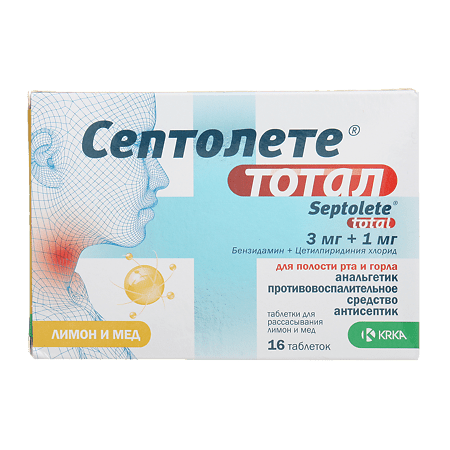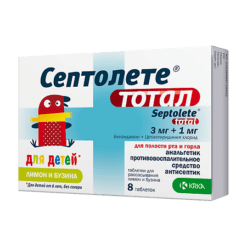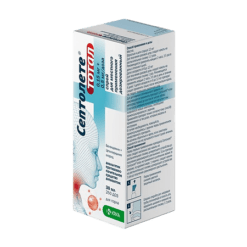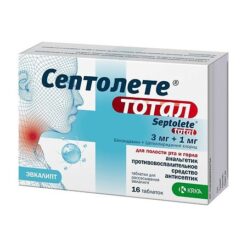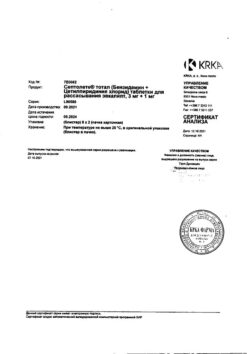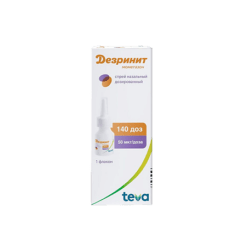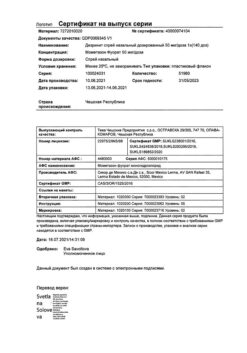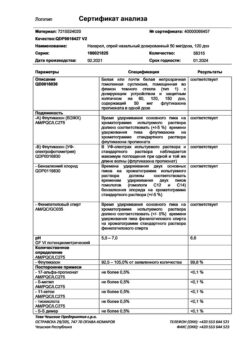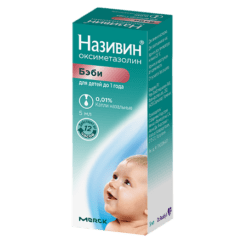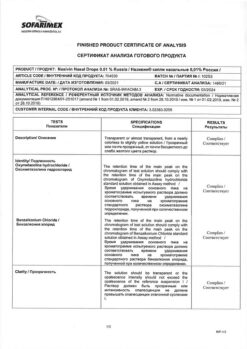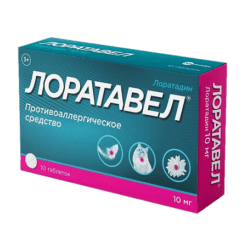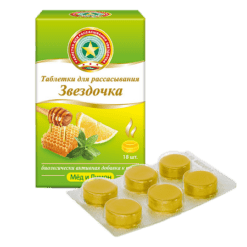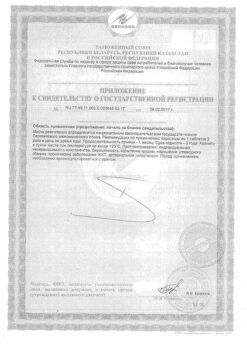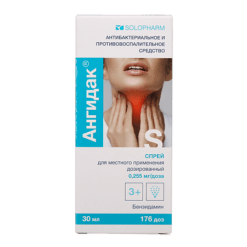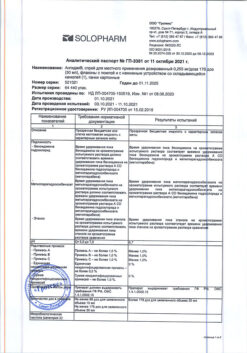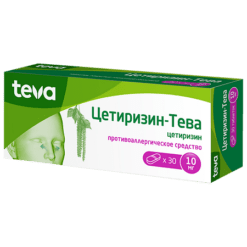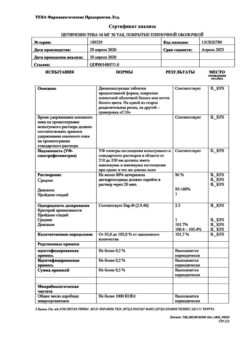No products in the cart.
Septollete Total lemon and honey, tablets 3 mg+1 mg 16 pcs
€12.25 €10.72
Description
Pharmacotherapeutic group: nonsteroidal anti-inflammatory drug + antiseptic
ATX code: R02AA20
Pharmacological properties
Pharmacodynamics
Benzidamine is a non-steroidal anti-inflammatory drug with anti-inflammatory, analgesic and local anesthetic action.
Cetylpyridinium chloride is an antiseptic from the group of quaternary ammonium compounds, has antimicrobial, antifungal, virulicidal action.
Pharmacokinetics
Intake
From the two active substances – cetylpyridinium chloride and benzidamine – only benzidamine is absorbed through the mucous membranes. Therefore, cetylpyridinium chloride does not interact pharmacokinetically with benzidamine at the systemic level. Absorption of benzidamine through the oral and pharyngeal mucous membranes was demonstrated by detecting the active ingredient in serum, the amount of which, however, was insufficient to exert systemic action. Absorption of benzidamine is higher when using dosage forms that dissolve in the mouth compared to topical dosage forms (e.g., oral spray).
Distribution. The volume of distribution of all dosage forms is the same.
Excretion. Excretion occurs mainly by the kidneys, to a greater extent in the form of inactive metabolites. The elimination half-life and the total clearance are similar for all dosage forms.
Indications
Indications
Symptomatic treatment of pain syndrome of inflammatory diseases of the oral cavity and ENT organs (of various etiologies).
Pharmacological effect
Pharmacological effect
Pharmacotherapeutic group: non-steroidal anti-inflammatory drug + antiseptic
ATX code: R02AA20
Pharmacological properties
Pharmacodynamics
Benzidamine is a nonsteroidal anti-inflammatory drug with anti-inflammatory, analgesic and local anesthetic effects.
Cetylpyridinium chloride is an antiseptic from the group of quaternary ammonium compounds, has antimicrobial, antifungal, and virucidal effects.
Pharmacokinetics
Suction
Of the two active ingredients – cetylpyridinium chloride and benzydamine – only benzydamine is absorbed through the mucous membranes. Therefore, cetylpyridinium chloride does not interact pharmacokinetically with benzydamine at the systemic level. The absorption of benzydamine through the mucous membranes of the oral cavity and pharynx was shown by detecting the active substance in the blood serum, the amount of which, however, was insufficient to provide a systemic effect. Absorption of benzydamine is greater with dosage forms that dissolve in the mouth compared to topical dosage forms (eg, oral spray).
Distribution. The volume of distribution of all dosage forms is the same.
Excretion. Excretion occurs mainly by the kidneys, mostly in the form of inactive metabolites. The half-life and total clearance are similar for all dosage forms.
Special instructions
Special instructions
Septolete® total should not be used for more than 7 days. If there are no noticeable signs of improvement, you should consult a doctor.
When using Septolete® total, hypersensitivity reactions may develop. In this case, it is recommended to stop treatment and consult a doctor to prescribe appropriate therapy. If there is an ulcerative lesion of the mucous membrane of the oropharynx, the patient should consult a doctor if symptoms persist for more than three days.
The use of Septolete® total is not recommended in patients with hypersensitivity to acetylsalicylic acid or other non-steroidal anti-inflammatory drugs.
The drug Septolete® total should not be used simultaneously with anionic compounds (for example, present in toothpaste).
Therefore, it is not recommended to use the drug immediately before or after brushing your teeth.
Concomitant use with milk may reduce the antimicrobial effect of cetylpyridinium chloride, therefore Septolete® total should not be used simultaneously with milk.
Impact on the ability to perform potentially hazardous activities that require special attention and quick reactions (for example, driving vehicles, working with moving mechanisms)
The drug Septolete® total does not affect the ability to drive vehicles or operate machinery.
Active ingredient
Active ingredient
Benzidamine, Cetylpyridinium chloride
Composition
Composition
1 lozenge contains:
active substance:
Benzydamine hydrochloride 3,000 mg
Cetylpyridinium chloride monohydrate 1,050 mg, equivalent to cetylpyridinium chloride 1,000 mg
excipients: eucalyptus leaf oil 1,200 mg, levomenthol 5,000 mg, sucralose (E955) 3,500 mg, citric acid (E330) 15,000 mg, isomalt (type M) (E953) 2471.285 mg, brilliant blue dye (E133) 0.015 mg.
Pregnancy
Pregnancy
The use of Septolete® total during pregnancy and breastfeeding is possible only after consultation with your doctor, if the expected benefit to the mother outweighs the potential risk to the fetus and child.
Contraindications
Contraindications
Hypersensitivity to the active substances or to any auxiliary components of the drug. Children’s age up to 12 years.
With caution
Hypersensitivity to acetylsalicylic acid or other non-steroidal anti-inflammatory drugs, bronchial asthma (including a history).
Side Effects
Side Effects
Classification of the incidence of side effects recommended by the World Health Organization (WHO):
very often >1/10
often >1/100 to <1/10
uncommon >1/1000 to <1/100
rarely from >1/10000 to <1/1000
very rare <1/10000
frequency unknown cannot be estimated from available data.
Immune system disorders: rarely: hypersensitivity reactions; frequency unknown: anaphylactic reactions.Nervous system disorders: frequency unknown: numbness of the oral mucosa.Disorders of the respiratory system, chest and mediastinal organs: rarely: bronchospasm.Gastrointestinal disorders are very rare: irritation of the oral mucosa, burning sensation in the cavityDisorders of the skin and subcutaneous tissues: rarely: urticaria, photosensitivity; frequency unknown: angioedema, skin itching.
Interaction
Interaction
Not studied. Simultaneous use with other drugs from the group of antiseptics should be avoided.
Overdose
Overdose
Symptoms: Toxic manifestations of benzydamine overdose include: agitation, convulsions, increased sweating, ataxia, chills and vomiting. Signs and symptoms of intoxication when ingesting significant quantities of cetylpyridinium chloride: nausea, vomiting, edema, cyanosis, asphyxia with subsequent paralysis of the respiratory muscles, depression of the central nervous system, arterial hypotension and coma. The lethal dose for humans is about 1-3 g.
Treatment: due to the lack of a specific antidote, treatment of acute benzydamine intoxication is symptomatic. Treatment of cetylpyridinium chloride overdose is also symptomatic. In case of overdose, consult a doctor.
Storage conditions
Storage conditions
At a temperature not exceeding 25°C, in the original packaging.
Keep out of the reach of children.
Shelf life
Shelf life
2 years. Do not use the drug after the expiration date.
Manufacturer
Manufacturer
KRKA dd Novo Mesto, Slovenia
Additional information
| Shelf life | 2 years. Do not use the drug after the expiration date. |
|---|---|
| Conditions of storage | At a temperature not exceeding 25 ° C, in the original package. Keep out of reach of children. |
| Manufacturer | KRKA dd Novo mesto, Slovenia |
| Medication form | lozenges |
| Brand | KRKA dd Novo mesto |
Other forms…
Related products
Buy Septollete Total lemon and honey, tablets 3 mg+1 mg 16 pcs with delivery to USA, UK, Europe and over 120 other countries.

